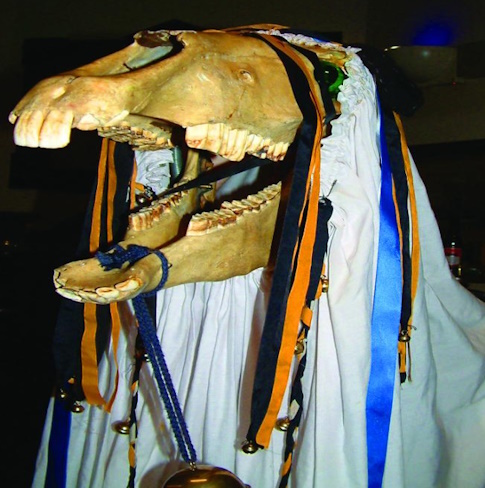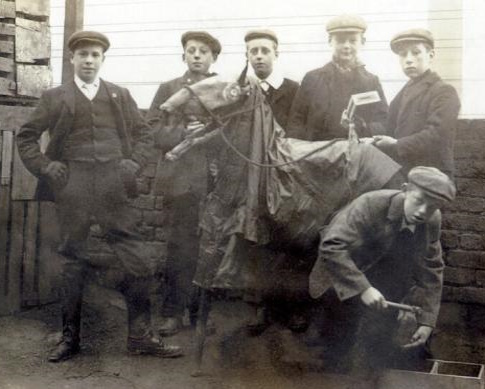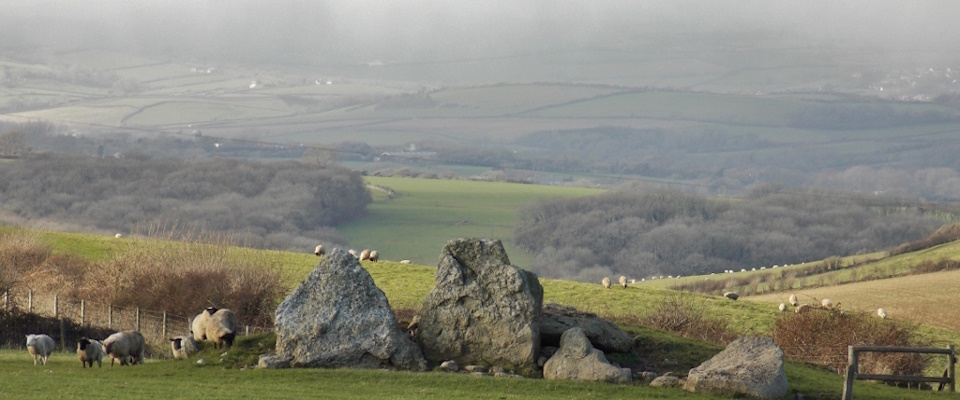Welsh Tradition in December - Mari Lwyd
Written by Anne Newman - 8th January 2020 updated 2023
The Mari Lwyd is an ancient mid-Winter tradition which is unique to Wales. The custom began at dusk and often lasted late into the night, during winter festivities, specifically around Christmas and New Year. However, the precise date on which the custom was performed varied between villages, and in a number of cases the custom was carried out for several consecutive nights and some regions wait until January.
A useful source of information is the Museum of Wales
| Mari Lwyd translates as the Grey Mare, Grey Mane or Grey Mary. |  |
The Mari Lwyd is a horse's boney skull, which is decorated with colourful lights or baubles for eyes, reins, bells and ribbons for the mane and the skull is then wrapped in a white sheet and placed on a pole. Someone goes underneath the sheet to carry it around the village accompanied by a procession of people who are often dressed in traditional costume.
In Irish folklore horse skulls were often buried in floors. Apparently this was to provide 'luck' for the inhabitants and also to improve the acoustics of the buildings (the hollow skull would resonate when stepped or danced upon). Irish Archaeology - buried horse skulls
The Mari and her group call to houses and try to gain access by performing a series of verses, known as pwnco, challenging families to a battle of rhyming insults in Welsh. The home owners respond with their own rhymes, in a fake battle to outwit the creature and prevent her from entering the house.
One common opening went:
Wel dyma ni’n dwad - Well here we come,
Gy-feillion di-niwad - Innocent friends,
I ofyn am gennad - To ask leave,
I ofyn am gennad - To ask leave,
I ofyn am gennad i ganu - To ask leave - to sing.
The battle can continue for as long as the two parties wish, but once it's over, the Mari is let inside - as this brings the household good luck for the future year.
The Mari and her followers are then given refreshments as the celebration continues inside before moving on to the next house.
This tradition is associated with South Wales and is rumoured to be the strongest and most unbroken tradition is in Llangynwyd, Bridgend.
Although the tradition declined in the early to mid-twentieth century, in part due to opposition from some local Christian clergy and changing social conditions, it was revived in new forms in the mid-to-latter part of the century.
Horse Traditions, Solar symbol and the Poor Old Horse
I wonder if these Grey Mare traditions and places are linked to old winter solar deity and symbols? Svetovid, a sun god of Slavic legends had a white stallion as his sacred animal. Dutch legends tell how Sinterklaas rides a grey horse. In Indian stories Lord Vishnu’s head was cut off accidentally by other gods. The head turned out to be the Sun. The gods then attached a horse head to Vishnu's body.
As we said the Mari Lwyd is unique to Wales, but it resonates across the world. And closer to home in the Poor Old Horse folk tradition in Dronfield, Derbyshire. The tale of the Poor Old Horse has been told for generations. During the period around Christmas and New Year, in pubs and houses, groups of performers (guisers) would act out a short play with a song, revolving around the symbolic death of an animal, involving the essential prop of a specially constructed animal head on a pole, operated by a performer beneath a cloak. Dronfield Poor Old Horse archive and history
| Group of boys performing Poor Old Horse at Dronfield, circa 1908 (Image: Dronfield Heritage Trust) |  |
Grey Mare and her Colts - Dorset
Set high on the ancient trackway and Britain’s oldest road, the Ridgeway, this Neolithic long barrow has views over the coast and countryside. It aligns with winter solstice sunrise and summer solstice sunset. Nearby is the river Bride. One legend has it that hidden under the Grey Mare stone is a coffin, made from solid gold. There is also a local legend that connects the barrow to a phantom horse that runs around the area. Reports of visits and many photographs






